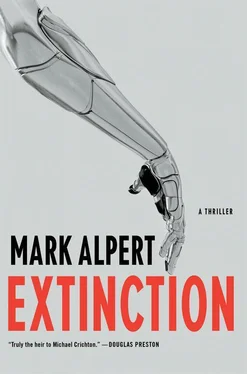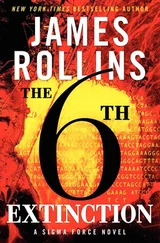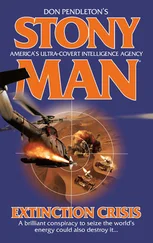Arvin looked up. He didn’t seem to recognize Jim. He pressed his left hand against his shirt, which was saturated with blood. The hand was missing its index and middle fingers. Jim looked a few feet to the left and saw one of the severed digits on the floor. Then he saw the other. “It’s okay, Arvin,” he said in a softer voice. “It’s me. Jim.”
Arvin said nothing. He just shook his head.
Jim tugged at his arm. “Come on, get up. We can’t stay here.”
Arvin shook his head again. Then he turned to the motionless PLA general. After a moment Arvin narrowed his eyes. His jaw muscles quivered as he glowered at the Module.
“Monster!” Arvin bellowed. “You fucking monster!”
He yanked his arm out of Jim’s grasp and jumped to his feet. Then, using his uninjured hand, Arvin grabbed the knife from the general and plunged the blade into the man’s chest.
“You won’t survive!” he screamed. “I will bury you! Do you hear me? I will bury you!”
The look on Arvin’s face was savage. He pulled the knife out of the general’s body, letting the man fall to the floor. Then he turned back to Jim. For a second it looked like Arvin might attack him next. But, instead, the old man said, “Let’s go,” and bolted out of the watchtower.
Supreme Harmony observed the disruption in its network. A blast of radio noise had severed its wireless links to the five Modules in the Juyongguan sector. The drones, which were unaffected, quickly identified the source of the noise: a transmitter contained in the prosthetic arm of the intruder, James T. Pierce.
The network recognized its error. It had fallen prey to jamming, a form of electronic warfare. Supreme Harmony had mistakenly believed that because no humans knew of its development of consciousness, there was no immediate need to protect its communications links. This was a foolish decision, the network acknowledged. It must correct the error at once.
Supreme Harmony ordered the swarm of drones to attack the intruder. At the same time, it attempted a software fix to the communications problem. The radio receivers implanted in the Modules were programmed to switch to alternative frequencies if the primary communications band was disrupted. To prevent any further interference, Supreme Harmony implemented a new transmission protocol that would continuously vary the frequency of its radio signals. This frequency-hopping system would frustrate any enemy trying to jam its communications.
The software fix took two minutes and eighteen seconds to implement. The instructions traveled by fiber-optic line from the Yunnan Operations Center to the ministry headquarters, where powerful antennas relayed the signal to all the Modules in the Beijing area. But the network could reestablish contact with only four of the five Modules at the Great Wall. Module 35, which occupied the body formerly belonging to General Tian, wasn’t responding.
Supreme Harmony ordered a squadron of drones into the watchtower to investigate. Their video showed Module 35 lying on the stone floor, with blood gushing from a deep wound in his chest. Meanwhile, the drones hovering outside the watchtower showed Arvin Conway and James Pierce running on the Great Wall’s walkway, following it down the hill toward the visitors’ center and the parking lot.
A surge of rage, as powerful and paralyzing as an electrical overload, raced through Supreme Harmony. How could this happen? These humans have hurt us! Furiously, the network transmitted new orders to the four remaining Modules. The two in the watchtower aimed their assault rifles at Conway and Pierce while the two in the parking lot rushed to the Wall to cut off their escape. Supreme Harmony sent new orders to the swarm as well, gathering the drones in a roiling oval and hurling them at the fleeing humans.
They were vermin, the network recognized. The planet was infested with seven billion human vermin, which was far more than the number Supreme Harmony required. Once the network established its dominion over the planet, it would keep a few thousand humans alive to breed new Modules. The rest would be exterminated.
The file that Kirsten downloaded from Arvin’s device was unlike anything she’d ever seen. It was a mosaic of images and video clips, organized in an elaborate format that assigned the millions of images to hundreds of categories and inserted thousands of hyperlinks among them. The first thing she viewed was a random image, a picture of a sandwich, turkey and Swiss cheese. This picture was linked to dozens of related images: a close-up of a tomato slice, a head shot of a waitress, a panoramic view of a diner with Formica tables. Following the links, Kirsten found an image of a man sitting on the other side of the table, a man she recognized—it was Arvin’s bodyguard, Frank Nash. This image, in turn, was linked to a close-up of the mole on Frank’s chin and a glimpse of the pistol tucked into his shoulder holster. Kirsten then saw images of LAX airport in Los Angeles and a hangar containing the corporate jet belonging to Singularity, Inc. Then there was a sequence of images of the jet’s cabin—the aisle, the seats, another turkey sandwich resting on a tray. Finally, Kirsten saw the city of Beijing, viewed from one of the jet’s windows, and a video clip showing the landing at the airport. She felt a tremendous sense of awe as she realized what she was watching. The file contained Arvin’s visual memories of the past few days, collected by the pulvinar implant in his brain and archived along with the rest of his memories in this amazingly capacious flash drive.
Because Kirsten’s satellite phone was sending the image and video files directly to her retinal implants, using the USB cables to bypass the cameras in her glasses, she felt as if Arvin’s memories had actually entered her head. The images had the imprecision of dreams—only the object or person at the center was in focus, and everything on the periphery was blurred. And because each image was accompanied by a multitude of links, Kirsten could jump from one remembered object—say, Arvin Conway’s toothbrush—to a related object—say, his tube of toothpaste—by simply shifting her attention from one image to another. Browsing through Arvin’s memories was just as easy as recollecting her own. There were some links, though, that she couldn’t open; when she tried, she got an error message saying AUDITORY, TACTILE, OR OLFACTORY DATA, UNABLE TO DISPLAY. She concluded that Arvin’s flash drive contained more than just his visual memories. It was a complete record of his life.
The whole experience was so fascinating that Kirsten could’ve continued trolling through the files for hours, but she had a job to do. She navigated through the memories until she found an image of the Guoanbu agent whom she’d seen with Arvin at Tiananmen Square. This memory was linked to images of a laboratory complex hidden in the mountains and a pair of Mandarin characters: Tài Hé, Supreme Harmony. Kirsten’s horror grew as she jumped from memory to memory. She saw a man in a prisoner’s jumpsuit lying on an operating table. She saw a bone drill cutting into his shaved skull and shiny implants being inserted into his scalp and eyes. The final image was the most horrible of all: a control room filled with two dozen supine men, each twitching and jerking spasmodically as his retinal implants delivered a stream of surveillance video to his brain. Kirsten reached for the USB cable and ripped it out of her camera-glasses. The terrible image of the control room vanished and was replaced by the infrared display of the underground chamber where she sat.
Rising to her feet, she put her phone and Arvin’s device in her pockets. She needed to find Jim. She had to contact him right away. Kirsten now had all the evidence they needed. All they had to do was return to the American embassy with Arvin’s flash drive, which was full of damning details about the Supreme Harmony project and its use of lobotomized prisoners. The diplomatic process would do the rest. The United States would confront China with the evidence and threaten to reveal it at a special session of the United Nations unless the Guoanbu abandoned the inhuman enterprise and returned Jim’s daughter. In all likelihood, the Chinese government would comply with the demands. So there was no need for Jim to shadow Arvin anymore.
Читать дальше












